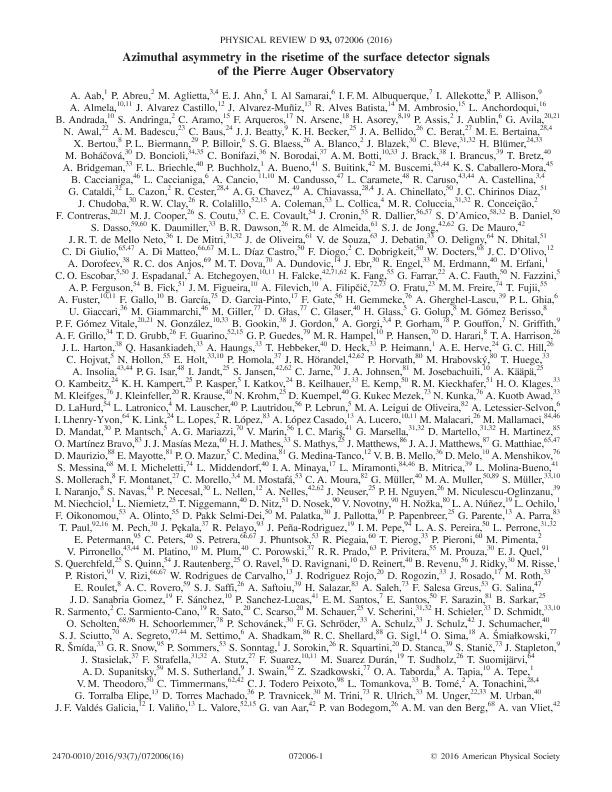Artículo
Azimuthal asymmetry in the risetime of the Surface Detector signals of the Pierre Auger Observatory
Allekotte, Ingomar; Almela, Daniel Alejandro ; Asorey, Hernán Gonzalo
; Asorey, Hernán Gonzalo ; Bertou, Xavier Pierre Louis
; Bertou, Xavier Pierre Louis ; Dasso, Sergio Ricardo
; Dasso, Sergio Ricardo ; Dova, Maria Teresa
; Dova, Maria Teresa ; Etchegoyen, Alberto
; Etchegoyen, Alberto ; Figueira, Juan Manuel
; Figueira, Juan Manuel ; Filevich, Alberto
; Filevich, Alberto ; Freire, Martín Miguel
; Freire, Martín Miguel ; Garcia, Beatriz Elena
; Garcia, Beatriz Elena ; Golup, Geraldina Tamara
; Golup, Geraldina Tamara ; Gomez Berisso, Mariano
; Gomez Berisso, Mariano ; González, Nicolás Martín
; González, Nicolás Martín ; Hampel, Matias Rolf
; Hampel, Matias Rolf ; Hansen, Patricia Maria
; Hansen, Patricia Maria ; Harari, Diego Dario
; Harari, Diego Dario ; Jarne, Cecilia Gisele
; Jarne, Cecilia Gisele ; Josebachuili Ogando, Mariela Gisele
; Josebachuili Ogando, Mariela Gisele ; Lucero, Luis Agustin
; Lucero, Luis Agustin ; Mariazzi, Analisa Gabriela
; Mariazzi, Analisa Gabriela ; Masías Meza, Jimmy Joel
; Masías Meza, Jimmy Joel ; Melo, Diego Gabriel
; Melo, Diego Gabriel ; Micheletti, Maria Isabel
; Micheletti, Maria Isabel ; Mollerach, Maria Silvia
; Mollerach, Maria Silvia ; Pallotta, Juan Vicente
; Pallotta, Juan Vicente ; Piegaia, Ricardo Nestor
; Piegaia, Ricardo Nestor ; Pieroni, Pablo Emanuel
; Pieroni, Pablo Emanuel ; Platino, Manuel
; Platino, Manuel ; Quel, Eduardo Jaime
; Quel, Eduardo Jaime ; Roulet, Esteban
; Roulet, Esteban ; Rovero, Adrian Carlos
; Rovero, Adrian Carlos ; Sanchez, Federico Andrés
; Sanchez, Federico Andrés ; Sciutto, Sergio Juan
; Sciutto, Sergio Juan ; Supanitsky, Alberto Daniel
; Supanitsky, Alberto Daniel ; Tapia Casanova, Alex Marcelo
; Tapia Casanova, Alex Marcelo ; Wahlberg, Hernan Pablo
; Wahlberg, Hernan Pablo ; Wundheiler, Brian
; Wundheiler, Brian ; The Pierre Auger Collaboration
; The Pierre Auger Collaboration
 ; Asorey, Hernán Gonzalo
; Asorey, Hernán Gonzalo ; Bertou, Xavier Pierre Louis
; Bertou, Xavier Pierre Louis ; Dasso, Sergio Ricardo
; Dasso, Sergio Ricardo ; Dova, Maria Teresa
; Dova, Maria Teresa ; Etchegoyen, Alberto
; Etchegoyen, Alberto ; Figueira, Juan Manuel
; Figueira, Juan Manuel ; Filevich, Alberto
; Filevich, Alberto ; Freire, Martín Miguel
; Freire, Martín Miguel ; Garcia, Beatriz Elena
; Garcia, Beatriz Elena ; Golup, Geraldina Tamara
; Golup, Geraldina Tamara ; Gomez Berisso, Mariano
; Gomez Berisso, Mariano ; González, Nicolás Martín
; González, Nicolás Martín ; Hampel, Matias Rolf
; Hampel, Matias Rolf ; Hansen, Patricia Maria
; Hansen, Patricia Maria ; Harari, Diego Dario
; Harari, Diego Dario ; Jarne, Cecilia Gisele
; Jarne, Cecilia Gisele ; Josebachuili Ogando, Mariela Gisele
; Josebachuili Ogando, Mariela Gisele ; Lucero, Luis Agustin
; Lucero, Luis Agustin ; Mariazzi, Analisa Gabriela
; Mariazzi, Analisa Gabriela ; Masías Meza, Jimmy Joel
; Masías Meza, Jimmy Joel ; Melo, Diego Gabriel
; Melo, Diego Gabriel ; Micheletti, Maria Isabel
; Micheletti, Maria Isabel ; Mollerach, Maria Silvia
; Mollerach, Maria Silvia ; Pallotta, Juan Vicente
; Pallotta, Juan Vicente ; Piegaia, Ricardo Nestor
; Piegaia, Ricardo Nestor ; Pieroni, Pablo Emanuel
; Pieroni, Pablo Emanuel ; Platino, Manuel
; Platino, Manuel ; Quel, Eduardo Jaime
; Quel, Eduardo Jaime ; Roulet, Esteban
; Roulet, Esteban ; Rovero, Adrian Carlos
; Rovero, Adrian Carlos ; Sanchez, Federico Andrés
; Sanchez, Federico Andrés ; Sciutto, Sergio Juan
; Sciutto, Sergio Juan ; Supanitsky, Alberto Daniel
; Supanitsky, Alberto Daniel ; Tapia Casanova, Alex Marcelo
; Tapia Casanova, Alex Marcelo ; Wahlberg, Hernan Pablo
; Wahlberg, Hernan Pablo ; Wundheiler, Brian
; Wundheiler, Brian ; The Pierre Auger Collaboration
; The Pierre Auger Collaboration
Fecha de publicación:
04/2016
Editorial:
American Physical Society
Revista:
Physical Review D: Particles, Fields, Gravitation and Cosmology
ISSN:
1550-7998
Idioma:
Inglés
Tipo de recurso:
Artículo publicado
Clasificación temática:
Resumen
The azimuthal asymmetry in the risetime of signals in Auger surface detector stations is a source of information on shower development. The azimuthal asymmetry is due to a combination of the longitudinal evolution of the shower and geometrical effects related to the angles of incidence of the particles into the detectors. The magnitude of the effect depends upon the zenith angle and state of development of the shower and thus provides a novel observable, ðsec θÞmax, sensitive to the mass composition of cosmic rays above 3 × 1018 eV. By comparing measurements with predictions from shower simulations, we find for both of our adopted models of hadronic physics (QGSJETII-04 and EPOS-LHC) an indication that the mean cosmic-ray mass increases slowly with energy, as has been inferred from other studies. However, the mass estimates are dependent on the shower model and on the range of distance from the shower core selected. Thus the method has uncovered further deficiencies in our understanding of shower modeling that must be resolved before the mass composition can be inferred from ðsec θÞmax.
Palabras clave:
Rayos Cosmicos
Archivos asociados
Licencia
Identificadores
Colecciones
Articulos(IAFE)
Articulos de INST.DE ASTRONOMIA Y FISICA DEL ESPACIO(I)
Articulos de INST.DE ASTRONOMIA Y FISICA DEL ESPACIO(I)
Articulos(ITEDA)
Articulos de INSTITUTO DE TEC. EN DETECCION Y ASTROPARTICULAS
Articulos de INSTITUTO DE TEC. EN DETECCION Y ASTROPARTICULAS
Citación
Allekotte, Ingomar; Almela, Daniel Alejandro; Asorey, Hernán Gonzalo; Bertou, Xavier Pierre Louis; Dasso, Sergio Ricardo; et al.; Azimuthal asymmetry in the risetime of the Surface Detector signals of the Pierre Auger Observatory; American Physical Society; Physical Review D: Particles, Fields, Gravitation and Cosmology; 93; 7; 4-2016; 1-16; 072006
Compartir
Altmétricas



